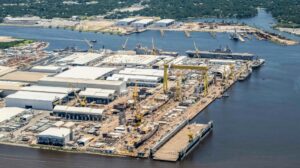The top Navy officer on Wednesday said he is optimistic on naval surface shipbuilding trends as the service looks to expand production of new ships and is also encouraged by the internal process for the 2024 defense budget.
Adm. Mike Gilday, Chief of Naval Operations, admitted the Navy will have to deal with inflation as it buys new Arleigh Burke
-class (DDG-51) guided-missile destroyers and Virginia-class (SSN-774) attack submarines, but since those two platforms are being procured in upcoming multi-year procurement contracts, “the one thing that obviously those multi contracts allow you to do is it gives us more predictability and stability with respect to what we’re going to need. And, so, there are economies of scale that we can leverage,” he said during a virtual event hosted by the Atlantic Council on Oct. 19.

Gilday also said that he is “an optimist when it comes to surface shipbuilding and the trends that we see right now.”
He said Fincantieri Marinette Marine in Wisconsin is starting to bend steel for the first Constellation-class frigate, FFG-62, “and they are comfortable right now with the profile that we had in the [fiscal year 2023] budget of one-two-one-two-one in terms of a building profile. They are going to get to two a year; they are phasing out, they are now almost done with LCSs and so they can focus purely on the frigates.”
Gilday also said the Navy wants to increase General Dynamics Bath Iron Works’ [GD] shipyard capacity to build destroyers.
“They’re now done with DDG-1000, those Zumwalts are out of the yard. They’re focused on flight three DDGs.”
He also said he is seeing “really good trends down there in terms of their shipbuilding performance” at HII’s [HII] Ingalls Shipbuilding yard in Pascagoula, Miss., and “I’m hopeful that it will improve even more.”
Gilday saw improvements as Austal USA’s shipyard in Mobile, Ala., shifts to add steel production and work on a new Coast Guard cutter, salvage ships, and work with another vendor for Ford-class carrier weapons elevators.
He added that General Dynamics’ NASSCO shipyard in San Diego “is doing a great job” on the John Lewis-class oilers as well.
“And so I’m encouraged by those trends. And I’m hopeful…with a $27.5 billion proposal that we can give the shipyards a much more predictable and stable set of headlights for ships that, no kidding, we really need to do two things: project power and to control the seas.”
Gilday noted operating the Navy is very expensive amid inflation and being fully funded by Congress is important.
“It’s noteworthy that in a day and age where we have at least 8.3 percent inflation right now, that 60% of the Navy’s budget rises at a rate above inflation. And so we have to take that into account, that maintaining the fleet that we have is extremely expensive.”
He said the Navy’s FY ‘23 $27.5 billion shipbuilding budget being debated in Congress right now is the biggest shipbuilding budget ever sent.
“And so we think, we’re hopeful that that will get approved, and that we can put ourselves on a healthier path with respect to shipbuilding, for industry, as well as for the Navy.”
When it comes to budgeting, Gilday said the first challenge to the Navy is the frequently-used continuing resolution that delays a final annual budget.

“Those delays are inefficient, they don’t make us more ready. They don’t make us more lethal, they’re a problem. And so the quicker that we get a budget for ‘23, the better, truly. “
However, when he considers the budget process for FY 2024, “I think I’m encouraged by the process that we have in the Pentagon right now, really prioritizing those things that threaten our pacing threat the most.”
Gilday said Pentagon leadership does not have much time to discuss nice-to-haves, “we’re talking about what we must have in order to…deter and fight and win. And so I’m encouraged in the path that we’re on right now.”
He noted that while not every decision in the building goes the Navy’s way when measured against the other services, “ we shouldn’t keep score like that. I am happy to put the Navy’s capabilities against others in different mission sets and may the best capability win in a joint force. We have to face it that way.”
“Our leadership is certainly driving us to look at problem sets much, much less parochially and more in terms of the metrics it takes – the analytics that in the end prove one capability over another,” he added.